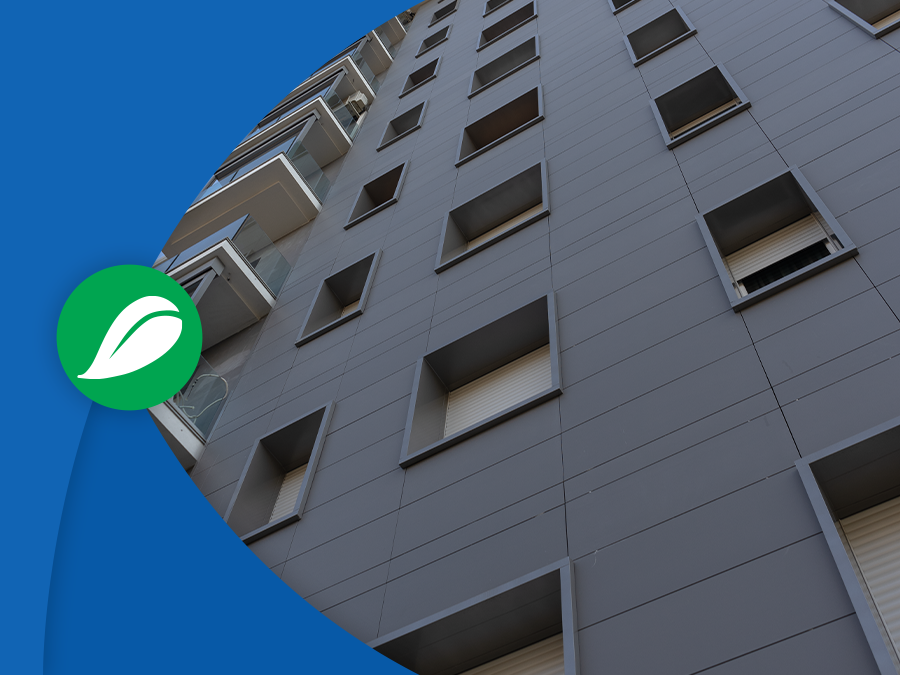Content index
Evolution and Performance Characteristics
UNI 11018-1:2023 is distinguished by a more detailed description than the previous version. The technical standard elaborates on the performance characteristics of ventilated façades, emphasizing the importance of energy efficiency, living comfort (both thermal and acoustic), durability and sustainability. These aspects are crucial for both new buildings and those subject to energy retrofits.
One of the most relevant innovations is the expansion of the range of materials considered for façade cladding, moving from an exclusive focus on stone and ceramics to a broader and more inclusive vision. This allows for greater design flexibility and a response that is more suited to the specific needs of each architectural context. In addition, it provides basic terminology and a detailed description of ventilated façade components, as well as metric calculation criteria.
However, it is important to note the exclusions specified in the standard. These include stone or brick façades, cases where the cladding is fixed directly to the load-bearing or insulation layer, facades used as disposable formwork for cast-in-place concrete or precast panels, and facades without ventilation. These exclusions clearly outline the limits of applicability of the standard and provide clear guidance for the design and installation of ventilated façades.
Energy Efficiency and Indoor Comfort
Ventilated façades offer significant advantages in terms of energy efficiency and indoor comfort thanks to the presence of an insulating layer attached to the perimeter structure and an air gap between the insulation and the external cladding. During the summer, the air gap allows the reduction of the heat flow, thus reducing the energy requirement for cooling, thanks to the so-called "chimney effect". This phenomenon occurs due to the thermal relationship between the temperature in the cavity and that of the incoming air, obtaining energy advantages also at an economic level. In winter, the cavity acts as an insulating air cushion, thanks to the closure of the ventilation grilles, reducing energy losses.
Sound insulation
The design of ventilated façades must ensure sound insulation in accordance with current standards, taking into account the function of use of the building. Sound insulation is influenced by the size and geometry of the cavity, the structure of the building, the vibrations of the cladding elements and the types of fastenings. This allows the elements to break up and dissipate the incident sound wave.
Durability and Maintenance
The standard requires ventilated façades to meet the expected performance characteristics for the entire useful period of the building's useful life. The durability of a ventilated façade depends on an ordinary and extraordinary maintenance activity foreseen in the design phase and specified in a maintenance plan. Compared to plaster-finished façades, ventilated façades offer superior durability and require less frequent maintenance and are easier to perform.
Reuse and Recyclability
In terms of environmental sustainability, the standard considers the possibility of disassembling the ventilated façade system for reuse, recyclability or proper disposal of its components. Ventilated façades with mechanical coupling, in particular, can be dismantled and reused elsewhere or recycled.
Safety in Case of Fire
Fire safety is a crucial aspect for ventilated façades. The standard refers to the Vertical Technical Rule of the Fire Prevention Code for "non-inspectable ventilated double-skin façades with closed external skin", including specific requirements such as the interruption of the cavity on each floor with smoke-tight elements and the protection of the internal skin from flame radiation.
Final Thoughts
The new UNI 11018-1:2023 standard represents an important step forward in the regulation of ventilated façades, offering a detailed and up-to-date picture of their performance characteristics. With a focus on energy efficiency, living comfort, durability, sustainability and safety, this standard is crucial for the design and construction of modern and sustainable buildings. Professionals must read and apply it correctly to ensure safe, efficient and comfortable buildings.

